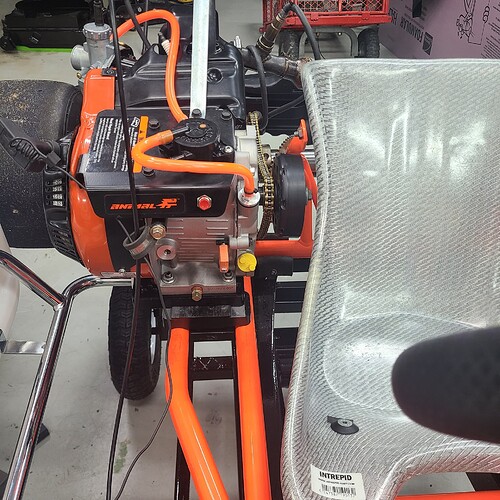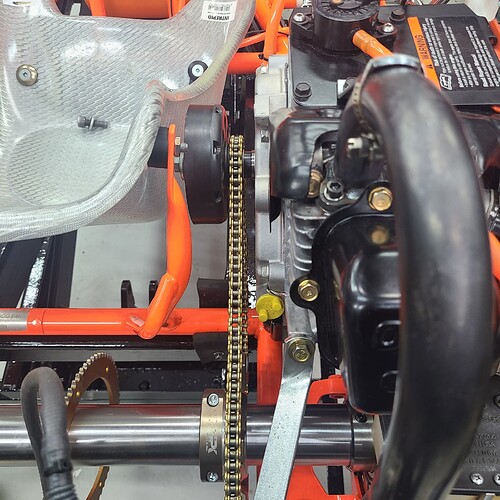That ain’t going on an IPK. ![]()
Just a small wrench to throw in… weight distribution calculators are based on static data, when your driving its dynamic. as you shift your weight in the seat, even moving your head does change the distribution. as well your target weight is actually once you’ve completed the race, so you can load up on fuel to balance the weight at the start, and then just deal with the distribution once it gets lower. can always pickup tyre marbles on the cool down lap if you really want to muddy the water on weight.
looking at your front distribution, I’ve typlically seen that much difference if the front is tweaked a bit or if its not setup the same. difference camber/toe/caster/tyre pressure/uneven floor. may want to confirm those first
Like I could afford anything with fancy hangers…
This is a valid way of tuning, but I think it is more of an old-school, American kart way of tuning. I remember the Margay team guys would be on the scales after every session and be tweaking the cross or weight distribution to tune, whereas us on the Euro karts used more of the chassis adjustments to tune the kart, and were only on the scales if something was bent or we were putting a seat in.
Not saying one way is right or wrong, both the Margay guys and us were winning races doing our own thing.
I think you are right. “Old school” is a very polite way of saying it ![]()
We tune cross without scales sometimes on those adjustables. ![]() 3 rounds of wedge, send it.
3 rounds of wedge, send it.
Couple rounds of wedge, a track bar adjustment, a set of four fresh Goodyear Eagles and a splash of Sunoco 110, boogity boogity boogity boys.
This response was meant for Jantjo:
Thanks, yes the scales are set up properly level to the .25mm, tire circumferences and pressures match across sides, fuel is at 1/2 expected range. Frame is straight off the assembly line and was told (I asked) that the dealer checked it on the table first.
For TJ et al, I consider myself data-driven and maybe some things are old school or passe. I am here to learn: Ive only been around karting a short time ~5 years. My scales are for the race cars and I dont anticipate weighing in between sessions but do check them after every accident and every other weekend. I’m also the guy 02 logging LO206s ![]()
I upgraded my floor pan to an aluminum one, now I can put my weights anywhere on there if I want. I popped for VLR pan, just required a little trimming to fit my non VLR kart. And suprisingly, all the bolt holes lined up perfectly.
Just throwing out options . . .
Thanks Dean. I guess that one is thicker than this one. Its aluminum but maybe 1.5mm thick.
For those that suggested moving things around, here is where I am on getting the motor/clutch/seat/stays to package together. I still need to leave some room for a clutch guard and some fore/aft movement for gear changes. I could try 1 more set of bolt holes over on this Odenthal. I would be at the next-last inboard setting.
Think I can go over more? Other suggestions for moving things around? A primary goal is to equalize the rears so to minimize uneven locking under braking.
Thanks!
Is the weight in question the only ballast on the kart?
Yep thats it. 20 characters.
I’m making an assumption that this is for a sportsman driver with the weight at 260.
If truly the case, placing the weight as others have mentioned in the center front is best option. Being that this is the only weight on the kart and you are only a few pounds off side to side in front and back, your driver will be fine.
Note: if you are shooting for a 260 weight class and you are at 261, you may want to add a lb or two. Good chance you run light on the track scales.
Tha ks for the thoughtful reply. Its Junior Lite LO206 265 lbs on a 1050 wheelbase Intrepid chassis. My boy will add a couple of pounds before April.
If that’s the only weight, that changes things slightly. I forget not everyone is running 50 lbs of lead like I always have…
I would just say put it in the center. The 1% off on cross will make almost no difference. And it seems like you’re a very detail-oriented and data-driven guy, but your point about equalizing the rear weights to evenly load the tires under braking shouldn’t be a huge concern either, since the wheels are connected, and in a junior 206 class there shouldn’t really ever be enough brake input that you lock the rears anyway.
Karts are supposed to be simple! Don’t overthink it too much.
The first time TJ has ever lied on KartPulse. Documenting for future conversations ![]()
They are supposed to be simple.
However:

I guess the fact that the guru’s “plateau of sustainability” does not appear to have a trajectory that would allow it to ever reach the height of Mt. Stupid’s peak tends to confirm this saying. ![]()

I myself am considering tying helium balloons to the kart to get to minimum weight.


